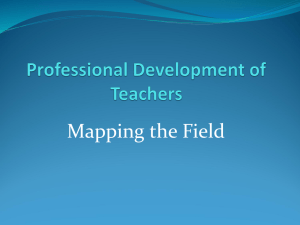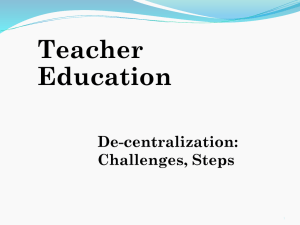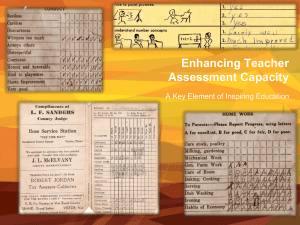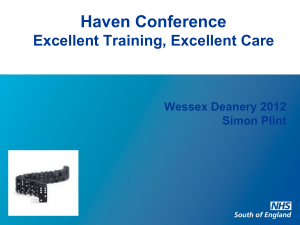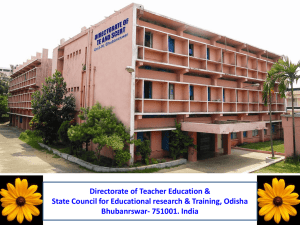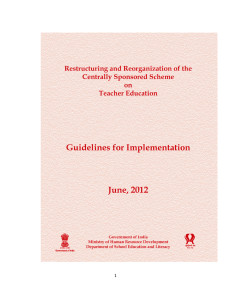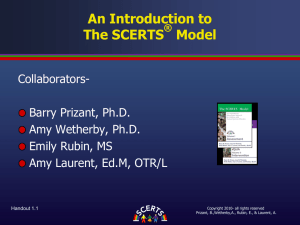Planning for Teacher Education
advertisement
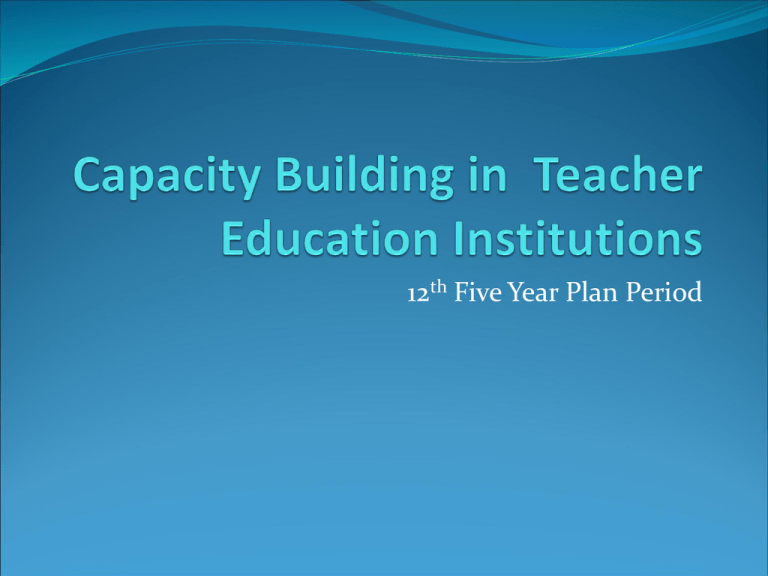
12th Five Year Plan Period Teacher Education Institutions (TEIs) Cluster Resource Centers (CRCs under SSA) Block Resource Centers (BRCs under SSA) Block Institutes of Education (proposed for 12FYP) District Institutes of Education (DIETs) State Council of Education Research and Training Colleges of Teacher Education (CTEs) Institute of Advanced Studies in Education (IASEs) University Colleges of Education University Departments of Education Private Institutes of Education affiliated to SCERT Types of Teacher Education provided in TEIs SCERT, DIETs, CRCs, BRCs provide In-service Education (INSET) DIETs: Elementary Teacher Education (D.Ed.) Institutes of Education affiliated to SCERTs provide D.Ed. and Pre-school Teacher Education University Colleges, Departments and CTEs provide Secondary Teacher Education (B.Eds.) University Departments/ IASEs provide M.Ed., M.Phil., Ph.d. in Education Role of teacher educators in SCERTs and DIETs SCERT and DIET teacher educators have a very large number of responsibilities: ETE Curriculum NTT Curriculum School curriculum School textbooks preparation Teaching-learning materials preparation Conducting pre-service D.El.Ed.Courses Conducting large numbers of in-service programs Role of teacher educators in SCERT and DIETs Overseeing affiliation, running of private TEIs for NTT and D.El.Ed./ETE Conducting entrance examinations for ETE , NTT Examination and certification for ETE and NTT Organize EduSAT programmes Conduct school based “action” research Work with schools in the lab area Participate in periodic school improvement programmes Participate in selection interview boards Address Parliament/Legislative Assembly questions Role of teacher educators in SCERTs and DIETs Training for MLL, SOPT, Joyful learning, multi-lingual education etc. Act as operating office and provide support to national and state committees on education Provide large scale teacher orientations for life skills, AIDs awareness, literacy mission, continuing education Variety of roles under SSA in material preparation, training, inspection Role of SCERTs and DIETs Gathering data for education surveys for NCERT Gathering data for DISE Gathering data for state Directorates of Education Participate in surveys of out-of-school children Provide orientation to school management committee members Census data collection Electoral rolls Election duty: Panchayat, Zilla, State , National elections Role of teacher educators in SCERT and DIETs Compared to the number of posts in SCERT and DIETs the work expected is astronomical. The CSS scheme guidelines provides for too few posts mostly envisaged for pre-service teacher education. When teacher educators are called away for a variety of tasks, pre-service training suffers greatly. SCERT, DIETs, teacher educators perform the bulk of the work but with little recognition or autonomy to design the initiatives or to time it according to their choice. Little attention is paid to expertise required, or the interest level of teacher educators. Work: Human power mismatch The CCS envisioning needs to keep in mind that they are district centers for education and training , and not just centres of teacher education. Clarity in terms of the tasks SCERT, DIETS are to perform and create commensurate posts before any discussion on quality or capacity building can be meaningful. It is time to work out teacher educator: teacher ratio, along the lines of teacher: pupil ratio specified in RtE. For preservice and in-service alone, a 1:60 ratio is required (1:50 for in-service, 10 pre-service) and additional posts for all other tasks. Categorizing the work of SCERT and DIET teacher educators It is impossible to do this satisfactorily, but, going by the generic capacities required, SCERT, DIET teacher educators would be involved in: Pre-service TE In-service TE Survey, research, documentation Educational Material Resource development and collation. Capacity-building of SCERTs and DIETs Cross-cutting sub-themes for capacity building : Needs Models Collaborations Materials Needs in Numbers: Units and Context of Planning for SCERT-DIETs The fundamental unit for all planning in education including teacher education is the catchment area. Mapping all children of the 3-14 age group, both in and out of school/pre-school provides the database for assessing educational needs such as number of schools classes and teachers required and their subject specializations (Language, Mathematics-Science, Social science). This in turn provides basis for number of teachers required and their specializations. Block/District as basis of TE Planning The number of teachers required, their specializations, the kind of teacher education programs needed, the curriculum and the continuous professional needs of teachers in schools is best undertaken preferably at the block, or at the district level. DIETs are mandated to work towards planning, teacher education and quality improvement of elementary education of the district. Elements of Planning for TE in districts District-wise number of teachers with required qualifications; without required qualifications. District-wise number of teachers without required qualifications. Additional teachers required in primary schools for PTR Additional language teachers required in middle schools Additional science-mathematics teachers required in middle schools Additional social science teachers required in middle schools Additional Head teachers required in primary and middle schools DIETs/Districts as basic unit of TE Planning Elements of Planning: Number of catchment areas. Schools in catchment areas, children in schools, children in catchment areas out of schools by age, male/female, SC, ST, Minorities, mother tongue, inschool, out-of-school, special needs. Teacher requirement based on total number of children of 6-14 age group and 3-6 age group. Teachers available in the block. Strategies for TE for additional teachers Increasing capacity of existing TEIs with NCTE approval Generating Faculty for increased capacity in collaboration with IASEs/universities Identifying institutions in the district where TE can be conducted: senior secondary schools, KVs, NVs, district higher and technical institutions, ITI? And generating Faculty and resources for this. Public-private partnerships in the district for TE. Strategies for generating Teacher Educators Incentives for those who enroll for teacher educator courses such as M.Ed. Generating M.Ed. Courses in HEIs. These could be specialization based, with institutions having expertise in the specializations e.g. Bose Institute, Science Centres, Sahitya academies. Providing study leave to school teachers to acquire teacher educator qualifications. Creating teacher education cadre for professional advancement. Strategies for capacity building of teacher educators Infrastructure and resource strengthening ICT Translations and collation of materials for TE Building/strengthening libraries Building resource units for Languages, Mathematics, Sciences, Social Sciences Documenting local resources as strategy for community engagement District based research studies Strategies for Teacher Educators Forum/Network for teacher educators. This can be inter-disciplinary as well as discipline based. Teacher educators will need to be oriented and assessments made part of TE curriculum Student performance will need to be observed, evaluated, recorded and portfolios maintained. How to do these will have to be first addressed by teacher educators. Documenting district resources as a strategy to both build capacity and provide input into school curriculum Capacity Building –some principles Capacity building most effective when embedded in the work of the teacher educator Clear performance based outcomes linked with rewards as part of the vision of capacity building Adequate quality materials Collective learning and sharing linked to institutional goals Best undertaken in-house with support from HEIs
